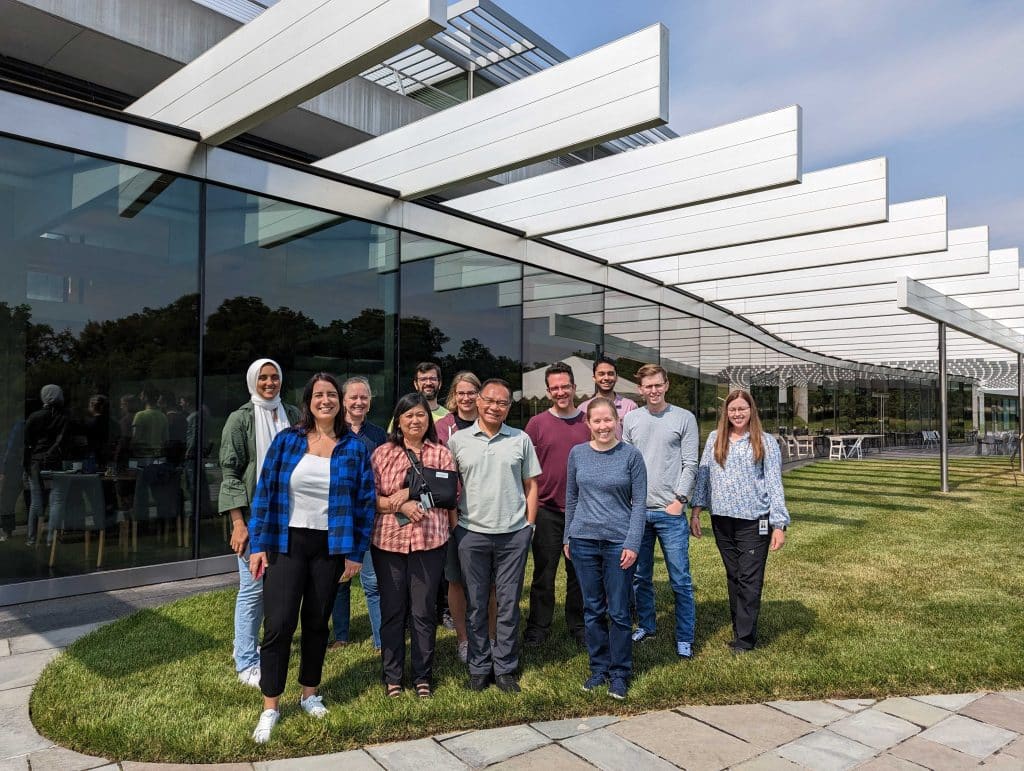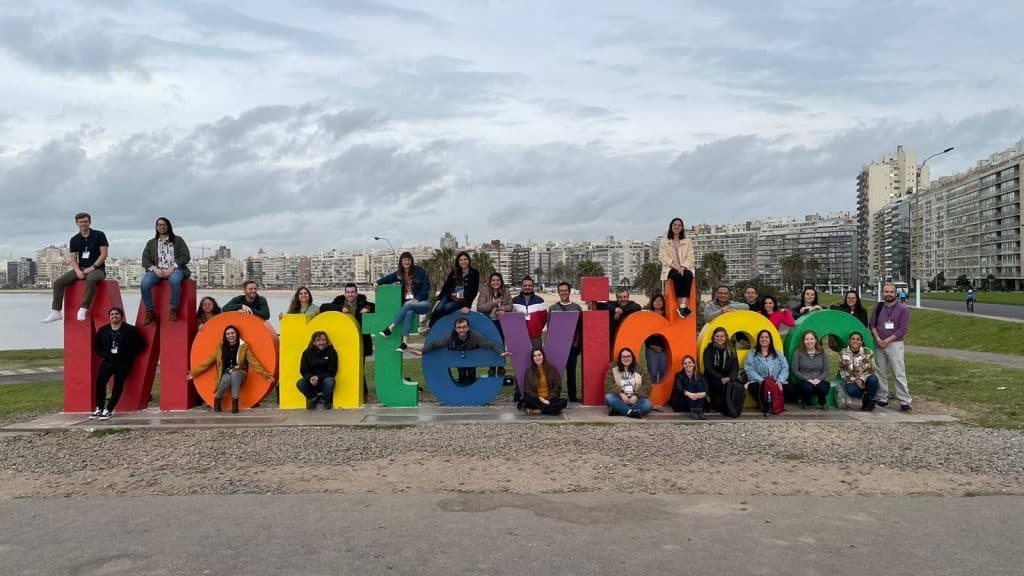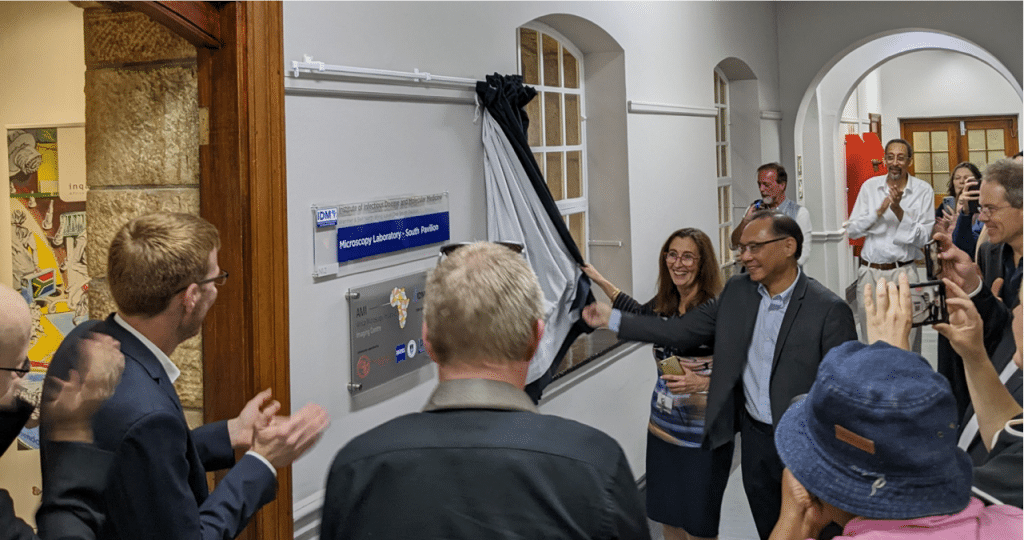‘How it (they) started with the Advanced Imaging Center (AIC)?’
Posted by Mai Rahmoon, on 21 July 2023
A series going behind the scenes to unveil the captivating origins of imaging communities and centers. I will unravel the stories that brought these hubs of innovation and discovery into existence. Behind every iconic center or community lies a tale of visionaries, pioneers, and passionate individuals who devoted their lives to pushing the boundaries of what was once deemed impossible. Moreover, I will not only focus on the past but also examine the present and gaze into the future of these communities and centers through insightful interviews.
My first interview is with Teng-Leong Chew, the Director of the Advanced Imaging Center (AIC) and the newly created Integrative Imaging platform at the Howard Hughes Medical Institute Janelia Research Campus. As a visionary and leader in the field of microscopy, Chew has spearheaded the establishment of a unique collaborative imaging center with global open access that serves as a gateway to Janelia’s cutting-edge microscopy capabilities. Throughout our conversation, Chew shared his insights into the remarkable journey that led to the creation of this groundbreaking center. With unwavering passion and dedication, he and his team have been instrumental in revolutionizing the way scientists and researchers access and utilize advanced microscopy technologies for their groundbreaking discoveries.

We all know you are the director of the AIC, but what was your journey to the AIC and how did the AIC start?
I started out as the director for the Center for Advanced Microscopy at Northwestern University in Chicago, right after I completed my postdoc at the same institution. I held that position from 2002 to 2014, a good 12 years. During that time, we expanded the imaging center from a two-instrument departmental core facility to one that housed more than 30 instruments. It catered to nearly 500 labs at Northwestern across both campuses and gained recognition as one of the Nikon Imaging Centers – I believe there are only seven or eight of them worldwide. Concurrently, I also became the Director for University of Imaging Resources, with the responsibility to streamline and coordinate the eight imaging centers at Northwestern for more efficient resource utilization and strategic balancing of expertise. That was my story in Chicago.
These combined roles were challenging. However, I must admit that despite being busy, I started to long for something more exciting, something radically different. It was around that time, in 2014, when Janelia decided to introduce a novel idea of making their pre-commercial microscopy technologies available to the rest of the world at practically no cost and not just accessible by Janelia scientists. What also intrigued me was that Janelia would offer significant institutional support to the visiting scientists to use the instruments. That was the transformative idea I was seeking. Who, in their right mind, would do something like that, right? So it became, in a way, a fascinating and intellectually challenging endeavor. The biggest question at the time was how to effectively manage and operate an imaging center of this nature. How do you cater to a user base that extends far beyond your own institution, reaching scientists from all corners of the world – an audience who may not even be familiar with these emerging technologies, let alone to realize that they need the instruments?
Was this the vision from the beginning?
Yes, even if you are a Janelia scientist, you have to write a proposal that undergoes peer review to use the AIC instruments. It is important to note that Janelia has its own set of duplicate instruments, so Janelia scientists never have to compete for the AIC instrument. From the very beginning, the AIC was designed to disseminate Janelia’s imaging technology to the rest of the world. At the time, nobody really knew how to run this imaging center, myself included. I thought that’s the challenge I craved, so let’s do it!
“MY MISSION IN LIFE IS TO DO SOMETHING FOR MY YOUNGER SELF“
That must have been an interesting interview process. Can you share that with us?
The interview was certainly an intimidating experience. I remember Reed George, Janelia Managing Director of Scientific Operations, asked me to give an informal presentation to a small audience – “just a handful of people,” he said. Well, in the room was the Founding Executive Director of Janelia, Gerry Rubin. There were also Karel Svoboda, Eric Betzig, Harald Hess, Rob Singer, Philipp Keller, and Tim Lionnet. That’s pretty much the who’s who in the field of advanced microscopy! What made it easier was that they asked a lot of questions and were genuinely interested in my vision of the AIC and that quickly turned into an exciting conversation. Nobody really knew how to run an imaging center like the AIC, there was no precedent. But my experience in running a large imaging center at Northwestern University, as well as being in charge of the institutional microscopy strategy allowed me to anticipate what could potentially go awry. And that in turn, informed how I addressed the questions during the interview and more importantly, guided us through the initial launch of the AIC.
So, let’s talk about Leong, what are your values in life?
Wow, that’s a tough question. I think coming from a country that has been repeatedly colonized and growing up with almost nothing, in the underprivileged region of the world, I always think that I’m an extremely lucky person to be able to make it to this level. Honestly, sometimes I still don’t know how I did that. In many ways, my current position at the AIC allows me a unique perspective on global science, and what I want to achieve in life by leveraging my position. I am immensely thankful to be given the opportunity to do so, and that so many people have been supportive of my ideas along the journey. In many ways, my mission in life is to do something for my younger self; the things that I wished people would have done for me when I was struggling in my earlier career stage.
This is the most amazing thing I’ve ever heard! So, what makes you get up in the morning?
Haha, what makes me get up in the morning is my dog. She’ll never let any of us sleep past, you know, 5:30 in the morning. All joking aside, I think that to be able to do something for the scientific community remains my biggest passion.
What’s your favorite aspect of your job?
Ah, it’s the people. Absolutely the people. Many would think that it was the technology, but no, it is the opportunity to interact with scientists from all over the world, especially with scientists from various forgotten corners of the world, to listen to their struggle and to find ways to solve problems for them. This is also true for scientists coming from privileged institutions in the United States and Europe; being able to find solutions to solve their scientific problems is what gets me excited. Being the AIC director, and being at Janelia, also offers me the firsthand exposure to the confluence of technology development, from hardware to software, from imaging probes to the most amazing biological projects, we are in the epicenter of it all. I love every minute of it!

Since getting to know you, I have always heard the word strategic in your sentences, so I kind of associate words like ‘strategic’, ‘strategy’, and other related terms with you. I’m curious to understand how these words define your vision, goals, and plans in life. Could you please share how the concept of strategy influences both your professional and personal aspects?
I think the word ‘strategy’ is just a buzzword. I am just a very pragmatic person. Whatever that I want to accomplish, it has to be result-oriented. Some people call that strategy, I just call it pragmatism. It is just that I want to see results and I don’t like to talk a lot with no action, and I don’t want to have actions with no plan. I don’t want to waste my time on aimless actions and discussion. So, I don’t think I ever really sit down and think whether or not whatever I’m doing is ‘strategic’. I care more whether what I’m going to do actually matters, and how I can use the least amount of effort to get the most results. So, in a way, you can say that I’m just lazy, I just don’t want to work too much.
Can you share with me like a turning point or a defining moment in your work?
I think there are two turning points, the biggest turning point was when I decided that I don’t really need to be a group leader or a lab head to make an impact on science. That was the day when I finally convinced myself to lead an imaging center and transform it from a small, shared resource to a foremost imaging center in the United States. This was when I was at Northwestern University: the day when I made that mental switch was the biggest turning point in my career and without it, I probably would not be leading an imaging center today, and certainly would not be involved in so many global imaging platforms. The second turning point was joining Janelia. How can it not be? Janelia does things very differently than most academic institutions, and it takes one a while to get used to that. Quite often, their approaches are groundbreaking, very disruptive, and very transformative. If it fails, it fails, or we learn from it and move on. That sort of can-do attitude and risk-taking culture makes it possible for many Janelia scientists to think big.
What makes the AIC stand out?
AIC is unique in several ways. First, it is 100% open-access to external users. More importantly, the fact that the AIC covers the costs of lodging, experiments, application scientist expertise and microscope time significantly eases the financial burden on our visiting scientists, allowing them to focus on what matters – their science. As you know, our support doesn’t end there, even after leaving the AIC, our support continues to assist in image analysis. Secondly, I am very proud to say that the AIC remains the global leader in educational outreach and technology dissemination. One would be hard-pressed to name another imaging center that could respond to the local needs, offering microscopy workshops not only where advanced microscopy tools are available, but in areas where resources are constrained. The reach of our train-the-trainers programs worldwide is second to none, culminating in success stories such as the Africa Microscopy Initiative, Imaging Africa, Imaging Latin America, and soon to other parts of the world. The impacts of these efforts have been significant and far-reaching.
The AIC have reached out to Latin America to Africa, you’re conquering the world and continents. So, tell us exclusively for the FocalPlane, what’s your next territory?
I wouldn’t say ‘conquering’. I was trying to bring access to other parts of the world. The next region on my radar is Asia and there is a good reason why it is my last frontier. It is because Asia is very complicated. It is culturally diverse, and it is geographically vast, stretching nearly across half the globe from the Pacific Rim all the way to the Middle East. It is unclear if it will ever be a ‘one size fits all’ approach to Asia. Until we have a chance to explore the issues facing that area, I am reluctant to speculate what the most ideal approach should be. But the goal of our outreach programs will always be about empowering scientists everywhere, through microscopy.

So, it’s not only about the offering of the technology in the global outreach and leadership, but it also includes investing in people. Over the last couple of years, the AIC started the AIC fellowship, can you tell me more about this opportunity and the diversity of the fellows that are joining.
The AIC fellowship is modeled after Jennifer Waters’ microscopy fellowship program at Harvard. I thought that was an absolutely fantastic idea, so why reinvent the wheel? But when we adopted Jennifer’s vision, we certainly tweak it a little bit to align it better with the AIC vision and the operational style of Janelia. The AIC fellowship program basically is created for people who have committed to the career path of an imaging application scientist or core facility leadership position. In other words, it is not designed for people who are still aiming to run their own lab. This is actually a rather important training program. Most people who embarked on the career path of core facility have never really been trained on how to be a successful core facility personnel, either as a manager, director or even an application scientist. It takes a lot of soft skills, as well as hard skills, to become successful in that career path. Hard skills, which involves learning optics, biology, image analysis, are easier to train, but what scientists quite commonly lack, unfortunately, are the soft skills. These include creating business plans, expanding the user base, designing workshops, developing training material, balancing a budget, managing a team, writing shared instrumentation grants, etc. None of those skills are taught in a graduate Program. The AIC fellowship is therefore an opportunity for people to develop both hard and soft skills. So that, in a nutshell, is what the AIC imaging fellowship is all about. Yet, what makes the AIC fellowship different is that we emphasize very strongly on international outreach. Every fellow who has come through the AIC fellowship program, has had opportunity to be involved in international workshops. Programs such as the Imaging Africa workshop and Imaging Latin America workshop, are all extra-curricular postdoc projects of the AIC imaging fellows. And so, each one of them has an opportunity to carve out a little bit of their time, and their effort to focus on outreach programs.
What changes would you make to improve how science is done globally?
We need a better strategy for research investment to significantly improve health research globally. New investment must be targeted with advisement and feedback from the scientific community. Scientific funding is often top-down, with governments determining which direction they want to drive science in. That kind of approach not necessarily is wrong, especially countries with more limited resources. It has met with some success, but it has also met with failure in other places. But it is important for the funding agencies and the federal governments to listen to scientists and have more active dialogues. And I think funding agencies must pay more attention to developing people, because it is the people that drive science. They fund projects, they fund instruments, but very few places invest in people, especially application scientists. Scientific technique is getting more and more complicated and very few labs can hire enough people to consolidate all the expertise. This means that more and more modern institution now appreciates the value of shared facilities, where application scientists with unique skill can drive the research technology faster, more effectively and more efficiently than any individual lab could. If you look at it from an institutional perspective, this is an extremely cost-efficient way of doing science. More importantly, these application scientists are the true pillars of institutional memories. What I mean by that is that a postdoc or graduate students, no matter how good they are, at some point they’re going to leave. And as soon as they leave, the lab usually scrambled to cover their departure and all the expertise and know-how that they carry with them. If you create job security for application scientists in any research technology, they become stable institutional memories, and they will continue to perpetuate that technology and that expertise in that institution. I think most institutions nowadays understand and appreciate that, but there is still not nearly enough funding to secure the career path of many application scientists. This would be a very simple cost-effective way to really revolutionize how we do modern science.
We come to the end of this interview and there is a one standout quote that truly resonate when he said:
“APPLICATION SCIENTISTS ARE THE TRUE PILLARS OF INSTITUTIONAL MEMORIES.”
Let the AIC story inspire you to begin your own imaging adventures and motivate you to start a similar endeavor.”


 (1 votes, average: 1.00 out of 1)
(1 votes, average: 1.00 out of 1)
This is really interesting. I enjoyed the write up. Mia, keep it up. My ears are itching to hear more from the blogs.
Wayy you go girlll